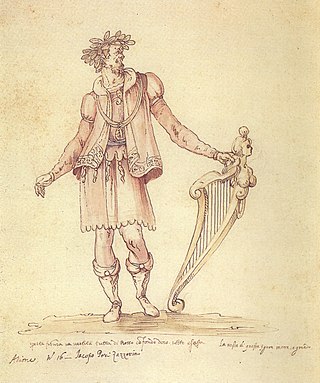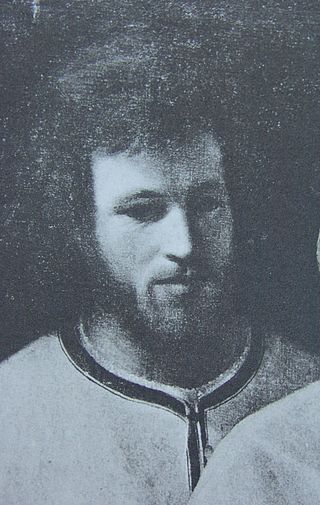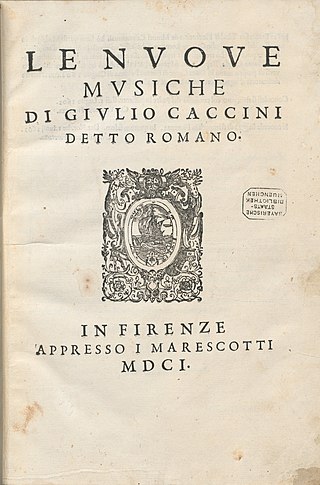
1589 (MDLXXXIX) was a common year starting on Sunday of the Gregorian calendar and a common year starting on Wednesday of the Julian calendar, the 1589th year of the Common Era (CE) and Anno Domini (AD) designations, the 589th year of the 2nd millennium, the 89th year of the 16th century, and the 10th and last year of the 1580s decade. As of the start of 1589, the Gregorian calendar was 10 days ahead of the Julian calendar, which remained in localized use until 1923.

Girolamo Savonarola, OP or Jerome Savonarola was an ascetic Dominican friar from Ferrara and a preacher active in Renaissance Florence. He became known for his prophecies of civic glory, his advocacy of the destruction of secular art and culture, and his calls for Christian renewal. He denounced clerical corruption, despotic rule, and the exploitation of the poor.

Jacopo Peri was an Italian composer, singer and instrumentalist of the late Renaissance and early Baroque periods. He wrote what is considered the first opera, the mostly lost Dafne, and also the earliest extant opera, Euridice (1600).
This article presents lists of the literary events and publications in 1589.
Cristofano Malvezzi was an Italian organist and composer of the late Renaissance. He was one of the most famous composers in the city of Florence during a time of transition to the Baroque style.

Philippe Verdelot was a French composer of the Renaissance, who spent most of his life in Italy. He is commonly considered to be the father of the Italian madrigal, and certainly was one of its earliest and most prolific composers; in addition he was prominent in the musical life of Florence during the period after the recapture of the city by the Medici from the followers of Girolamo Savonarola.

The intermedio, in the Italian Renaissance, was a theatrical performance or spectacle with music and often dance, which was performed between the acts of a play to celebrate special occasions in Italian courts. It was one of the important precursors to opera, and an influence on other forms like the English court masque. Weddings in ruling families and similar state occasions were the usual occasion for the most lavish intermedi, in cities such as Florence and Ferrara. Some of the best documentation of intermedi comes from weddings of the House of Medici, in particular the 1589 Medici wedding, which featured what was undoubtedly both the most spectacular set of intermedi, and the best known, thanks to no fewer than 18 contemporary published festival books and sets of prints that were financed by the Grand Duke.

Giovanni de' Bardi, Count of Vernio, was an Italian literary critic, writer, composer and soldier.

Emilio de' Cavalieri, or Emilio dei Cavalieri, was an Italian composer, producer, organist, diplomat, choreographer and dancer at the end of the Renaissance era. His work, along with that of other composers active in Rome, Florence and Venice, was critical in defining the beginning of the musical Baroque era. A member of the Roman School of composers, he was an influential early composer of monody, and wrote what is usually considered to be the first oratorio.

Giulio Romolo Caccini was an Italian composer, teacher, singer, instrumentalist and writer of the late Renaissance and early Baroque eras. He was one of the founders of the genre of opera, and one of the most influential creators of the new Baroque style. He was also the father of the composer Francesca Caccini and the singer Settimia Caccini.

Ottavio Rinuccini was an Italian poet, courtier, and opera librettist at the end of the Renaissance and beginning of the Baroque eras. In collaborating with Jacopo Peri to produce the first opera, Dafne, in 1597, he became the first opera librettist.

Francesco I was the second Grand Duke of Tuscany, ruling from 1574 until his death in 1587. He was a member of the House of Medici.

The House of Strozzi is the name of an ancient Florentine family, who like their great rivals the Medici family, began in banking before moving into politics. Until its exile from Florence in 1434, the Strozzi family was by far the richest in the city, and was rivaled only by the Medici family, who ultimately took control of the government and ruined the Strozzi both financially and politically. This political and financial competition was the origin of the Strozzi-Medici rivalry. Later, while the Medici ruled Florence, the Strozzi family ruled Siena, which Florence attacked, causing great animosity between the two families. Soon afterward, the Strozzi married into the Medici family, essentially giving the Medici superiority.
Dafne by Jacopo Peri was the earliest composition considered opera, as understood today, although with only five instrumental parts it was much more like a chamber opera than either the preceding intermedi or the operas of Claudio Monteverdi a few years later. It was written around 1597, largely under the inspiration of an elite circle of literate Florentine humanists who gathered as the "Camerata". Significantly, Dafne was an attempt to revive the classical Greek drama, part of the wider revival of antiquity characteristic of the Renaissance. The members of the Camerata considered that the "chorus" parts of Greek dramas were originally sung, and possibly even the entire text of all roles; opera was thus conceived as a way of "restoring" this situation. The libretto was by Ottavio Rinuccini, who had written some of the 1587 Medici intermedi, in which Peri had also been involved; Rinuccini appears to have recycled some of the material, at least from the scene illustrated at right. Most of the music for "Dafne" is lost, but one of Peri's many later operas, Euridice, dating from 1600, is the first opera score to have survived to the present day.

A crown-cardinal was a cardinal protector of a Roman Catholic nation, nominated or funded by a Catholic monarch to serve as their representative within the College of Cardinals and, on occasion, to exercise the right claimed by some monarchs to veto a candidate for election to the papacy. More generally, the term may refer to any cardinal significant as a secular statesman or elevated at the request of a monarch.
Andrea Salvadori was an Italian poet and librettist. He was born in Florence and educated at the Collegio Romano in Rome. From 1616 until his death in Florence at the age of 43, he was the principal court poet to the Medici family. In addition to numerous theatrical entertainments and poems, he wrote the libretti for five operas, four of which have survived, although only La Flora composed by Marco da Gagliano and Jacopo Peri has an extant score. He was married twice, first to Emilia Rigogli by whom he had three sons and then to the painter Alessandra Furini. A collection of Salvadori's principal works curated by his son Francesco was published in 1668.

Modo Antiquo is an Italian instrumental ensemble dedicated to the performance of Baroque, Renaissance, and Medieval music. It was founded in 1984 by Federico Maria Sardelli. Twice nominated for a Grammy award, the ensemble has an extensive discography, primarily on the Naïve, Brilliant Classics, and Tactus labels and have given the first performances in modern times of several works by Vivaldi. Modo Antiquo's larger ensemble is its Baroque orchestra led by Sardelli. It also has a smaller ensemble devoted to Medieval and Renaissance music led by Bettina Hoffmann.

The Opéra de Dijon is an opera company and arts organization in Dijon, France. It administers both the Grand Théâtre de Dijon and the Auditorium de Dijon which are its main performance venues. In addition to operas, the organization also stages ballets and classical music concerts.

Orfeo dolente is an opera by Domenico Belli to a libretto by Gabriello Chiabrera, an example of "representative style" of the early Baroque era. The work is divided into five interludes which were performed for the first time as intermedi in a performance of Torquato Tasso's play Aminta at the Palazzo della Gherardesca in Florence in 1616.
Ballo del Granduca, SwWV 319, is a composition for solo keyboard instrument attributed to Jan Pieterszoon Sweelinck.















